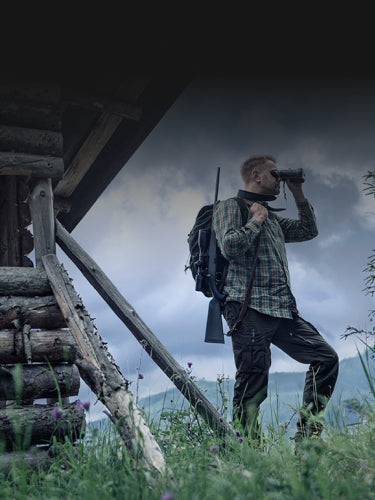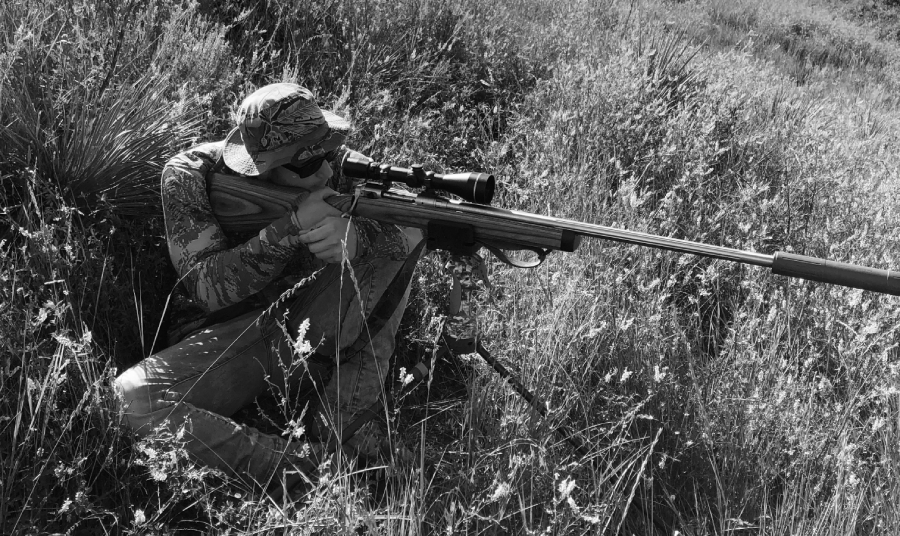Hunting has been a tradition among humans from the very beginning. Weapons have always been the main tools of this tradition, ranging from slings, boomerangs, bows, spears, up to modern rifles. Many different animals have been taken with these various weapons to provide food and clothing, essential for the sustenance of mankind and later for commerce that fed the growth of civilizations. Today, we will be discussing the weapons currently used for hunting coyote—an animal killed not to be eaten, but rather for its prized thick winter coat. I will cover the weapons being used by hunters today and the scenarios in which they are best applied. These weapons include rifles, pistols, bows, traps, and even dogs.
The first and most popular coyote hunting weapon is the rifle. There are many different variations and modifications available, such as telescopic scopes, suppressors, bipods, adjustable stocks, and much more. The most basic coyote stand is an area with an open field surrounded by cover where a coyote may or may not be foraging, which is why a rifle is the best option for a successful kill. Rifles can either be used with open sights or with a telescopic scope, allowing for shots out to over a thousand yards. Many hunters today use thermal scopes, such as the Pulsar Thermion 2 LRF XL50, to gain the advantage of hunting at night by detecting the heat of the coyote. To aid in making steadier, more accurate shots, most hunters equip their rifles with suppressors to quiet the gunshot, bipods or tripods to stabilize their rifles, and telescopic scopes to ensure accuracy at longer distances. The rifle is the most versatile weapon for hunting coyotes since it offers the best chance of success.

The next weapon that might be used to hunt coyotes, although not very popular, is the pistol. Pistols are known for their close-range lethality but are generally inaccurate at long distances, making them an uncommon choice in the coyote hunting world. Many pistols can be equipped with accessories similar to those used with rifles, such as suppressors and telescopic scopes, although these pistol optics have vastly greater eye relief and much less magnification than those found on rifles. Lasers are another accessory popular for pistols, enabling pistol hunters to make more accurate shots with a visible aiming device. Although pistols are limited in their capabilities, they offer an option for coyote hunters who enjoy the challenge.

A more popular option for close-range coyote hunting is the bow and arrow. There are several types of bows, such as the modern compound bow, longbow, or crossbow, the last of which is considered to be the most accurate and powerful archery weapon. The crossbow is similar to a rifle in that it is often mounted with a telescopic scope and able to shoot up to 80 yards with considerable power and accuracy. Unlike long and compound bows, crossbows allow the shooter to draw and lock the string in place, often with a lever assist. The shooter then uses a trigger much like a rifle to release the crossbow bolt. The compound bow is also powerful but can be challenging to shoot accurately for some, since a bow is much more difficult to shoot than a rifle. Compound bows use a pin sight system for aiming, and the hunter's steadiness determines the shot's accuracy. When properly shot, compound bows can be effective at distances of 60 yards or more. Another bow, variations of which were historically used by both the Native Americans and the English, is the longbow. Traditional longbows lack modern sights or equipment to assist with accuracy, relying entirely on the hunter's skill and instinct to point and aim. While the most powerful longbows can shoot up to 250 yards, the most common effective range hovers at around 50 yards, although bow hunters usually shoot game at far closer ranges to be ethical. Coyote hunting with any of these types of bows is more challenging, requiring stealth and skill to get close enough to the elusive coyote for a shot. The best option for bow hunting coyotes is in wooded areas or thick, brushy landscapes such as semi-arid deserts. Bows are a great way for hunters to learn new tactics and gain a deeper understanding of coyote behavior and patterns.

Trapping coyotes has also been a tradition for many outdoorsmen. Although trapping doesn't quite fall under the category of hunting, it is worth mentioning due to its effectiveness. There are many methods and techniques for trapping coyotes which are still widely practiced today. States often hire trappers to set up traplines on cattle and sheep ranches that have significant coyote problems. Trapping allows for extensive coverage of land where coyotes travel, without the need for the trapper to be present. Many states require traps to be checked within twenty-four hours, but a well-set trapline can yield hundreds of coyotes in a month or two. The most common coyote traps are footholds and snares. Foothold traps, especially for coyotes, are best used when boiled and waxed to remove any human scent. These traps are placed in a "bowl" dug out by the trapper, covered with a pan cover, and then disguised with dry or waxed dirt. Bait is often placed in a small hole about 7-8 inches deep near the trap to lure the coyote. Snares are set along paths and trails that coyotes frequently use. This type of trap catches the coyote by the neck or body and tightens as the animal pulls away, ultimately leading to its death. Trapping is an excellent option for those who don't have the time to hunt during daylight hours and is a rewarding after-work hobby
The last method of coyote hunting I'll discuss is using decoy dogs. Decoy dogs are well-trained in obedience, spotting, chasing, and luring coyotes toward the hunter, who is ready to take them out. Most hunters will be equipped with a rifle and scope, along with some of the accessories already mentioned. Decoy dogging, as it is called, is the most exciting method to watch. Coyotes often forget to be cautious when they see another dog invading their territory, allowing the decoy dogs to lure them in close to the hunters. This method provides excellent opportunities for videography and photography of coyotes, as the animals become so focused on the dogs that they lose all sense of alertness. Although decoy dogging is not the most popular method due to its challenges, those who engage in it with trained dogs have some of the most exhilarating experiences.

The tools mentioned above are the most common ways to hunt coyotes. Human ingenuity will continue to produce new, fun, and challenging methods to get the elusive coyote into the crosshairs, helping farmers and ranchers eradicate these problem creatures. This was just a basic overview of the tools people use to hunt coyotes—it's up to you to learn from others, gain experience, and embrace the challenges to make this pursuit even more exciting.
If our products have helped you in any way, share your story with us! Accepted stories will receive a 20% discount code.
Frequently Asked Questions
What is the most popular weapon for hunting coyotes?
The most popular weapon for hunting coyotes is the rifle due to its versatility and long-range accuracy.
Are pistols commonly used for coyote hunting?
Pistols are not commonly used for coyote hunting as they are generally inaccurate at long distances.
What is a popular option for close-range coyote hunting?
A popular option for close-range coyote hunting is the bow and arrow, particularly the crossbow for its power and accuracy.
Do hunters use traps for coyote hunting?
Yes, traps are sometimes used for coyote hunting as a method to capture the animal without having to shoot it.
How do thermal scopes help in coyote hunting?
Thermal scopes help in coyote hunting by detecting the heat signature of the animal, allowing hunters to see them in the dark.





